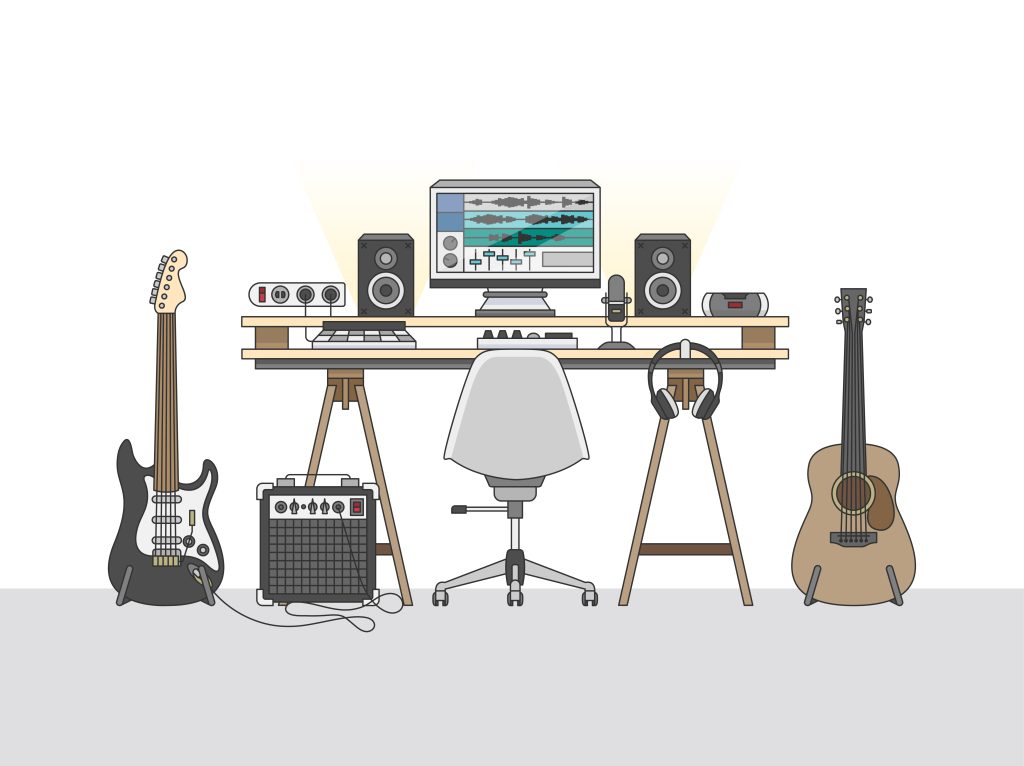Do you have a strong interest in music production and a desire to establish your very own home recording studio? Crafting a designated area for your musical pursuits marks a thrilling and fulfilling undertaking. Irrespective of whether you’re a seasoned musician or a passionate hobbyist, cultivating a well-furnished home recording studio can significantly elevate your creative journey. Within this all-encompassing manual, we will lead you through the fundamental phases of creating your personal home recording studio, tailored to your requirements, and fostering the growth of your musical concepts.
1. Planning Your Studio Space
Before diving into the equipment and technical details, it’s crucial to plan your studio space effectively. Consider the following factors:
Location and Acoustics
Choose a room that is acoustically favorable. Opt for space with minimal external noise and good sound isolation. You can also use acoustic treatment to control sound reflections within the room, ensuring optimal audio quality.
Room Layout
Arrange your studio layout thoughtfully. Place your recording equipment, instruments, and workstation in a way that promotes a seamless workflow. A well-organized space enhances efficiency during recording and mixing sessions.
Ergonomics
Invest in comfortable furniture and ergonomic accessories. Your comfort while recording and mixing will contribute to better productivity and extended creative sessions.
2. Essential Equipment
In order to produce recordings of a professional caliber, it’s essential to possess the appropriate equipment. Here’s a compilation of indispensable items:
Microphones
Choose microphones that suit your recording needs. Dynamic microphones are ideal for vocals and instruments, while condenser microphones capture detailed sounds and are great for acoustic instruments and vocals.
Audio Interface An audio interface establishes a connection between your instruments and microphones and your computer.
Studio Monitors
Invest in accurate studio monitors to ensure you hear your recordings accurately. Balanced sound reproduction is essential for mixing and mastering.
Headphones
Closed-back headphones are crucial for tracking and recording sessions, while open-back headphones provide a more accurate representation for mixing and editing.
Cables and Stands
High-quality cables and a sturdy microphone stand to prevent technical issues and ensure stability during recording sessions.
3. Software and Digital Tools
Software plays a pivotal role in modern home recording studios. Here are some essential software and digital tools to consider:
Digital Audio Workstation (DAW)
Select a digital audio workstation (DAW) that resonates with your preferences and workflow style. Well-known choices encompass Ableton Live, Pro Tools, Logic Pro, and FL Studio.
Virtual Instruments and Plugins
Enhance your sound palette with virtual instruments and plugins. These tools offer a wide range of sounds and effects to elevate your recordings.
Audio Editing Software
For precision editing, invest in audio editing software. This helps you trim, arrange, and polish your recordings before the mixing phase.
4. Acoustic Treatment
Achieving optimal sound quality requires proper acoustic treatment:
Bass Traps
Bass traps minimize low-frequency buildup, ensuring a balanced sound in your recordings.
Diffusers
Diffusers scatter sound reflections, reducing acoustic anomalies in your studio space.
Absorption Panels
Place absorption panels strategically to control sound reflections and create a neutral sonic environment.
5. Workflow and Productivity
Efficiency is key in a home recording studio:
Set Up Templates
Create recording templates with pre-configured tracks, effects, and settings to save time during project setup.
Organize Files
Maintain a structured file organization system to quickly locate and access your recordings and project files.
Regular Maintenance
Keep your equipment clean and well-maintained to prevent technical glitches and ensure consistent performance.
Embarking on the journey of setting up a home recording studio is a thrilling endeavor that demands meticulous planning and financial commitment. By following these guidelines and tailoring them to your specific needs, you will establish an environment where your musical concepts can truly flourish. Remember, with the right equipment, effective acoustic treatment, and an efficient workflow, you can pave the way for success as a home recording artist. So, are you prepared to commence your path to sonic excellence?
And don’t forget, Jobbi Recording Studio in Kharar Mohali stands as a pinnacle of excellence, adding an exceptional touch to your musical creations.

